As Morne Morkel shouldered arms to a straighter one by Ravichandran Ashwin, the ball kissed the off-stump, and India had beaten South Africa 3-0 in the series. The series had started with a rank turner at Mohali, where South Africa could not handle the spin-twins, Jadeja and Ashwin.The demons in their minds seemed to outweight the demons in the pitch, as most batmsen fell to pre-meditated shots. The match was over in 3 days, which led to criticism of the pitch, So, a neutral pitch was prepared in Bangalore, but South Africa still failed to capitalize on it, folding for just 214. But persistent rain washed out all chances of a result.The third pitch was even more vicious than the first, as balls spat up from the pitch on Day 1. While India pushed and heaved to 215, South Africa showed a white flag almost immediately and collapsed for 79. Set a target of 310, South Africa put up a bit more resistance – showing that pitch was not as tough as it was made out to be, but were eventually overrun by the Indian spinners.The fourth test at Delhi showed the best pitch of the series – one which was good for batting, but still had something for the seam bowlers.Once again, South Africa were completely outmatched as India first scored 334 and then bowled them out for 121. Kohli did not enforce the follow on, but opted to bat and set an unassailable target. Set to chase 481, South Africa completely changed gears, resorting to block their way out trouble. They did not score more than 1 run an over, and ended Day 4 on 72 runs from 72 overs. But they still had 90 more overs to bat, which proved to be impossible. They were bowled out for 143 in the final session, and India completed the rout.The Indian team were undoubtedly the better team in the series, but South Africa also saw one or two good performances. Let’s take a look at the combined India-South Africa XI for the Test series:
#1 Murali Vijay
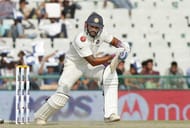
Once again, India’s most consistent batsman over the last two years stepped up to the plate when it mattered the most. Murali Vijay, nicknamed ‘Monk’, batted with his trademark patience and determination to keep the South African bowling attack at bay for most of the series. Opening the innings, Vijay made it his job to see off the new ball bowlers and wait till the pitch became relatively easier to bat on.
Knowing that his partner Shikhar Dhawan wasn’t in the best of form, Vijay harboured the strike and helped take the shine off the ball. Once the early morning swing abated, he played his range of strokes. His scores of 75 and 47 in the first Test were crucial towards taking India to a good score on a wearing pitch. Vijay did not look as if he was bothered by the turn on offer, often stepping out and lofting the bowlers over cover. He rose in confidence with every over, and India managed to beat South Africa,
Before the rain, Vijay had managed to get a good score in the second Test when he was on 28 off 73 balls. In the third test again, he put on a 50-run opening stand with Dhawan on a rank turner, scoring 40 runs in the process. It would go down as the highest score in the match. Vijay was unlucky to be dismissed caught behind after the ball hit the arm guard in the fourth Test, but his knocks in the first half of the series set it up for India.
#2 Dean Elgar
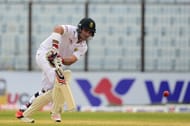
Dean Elgar was one of the slightly better performers for South Africa in the first two tests of the tour as he showed some resistance against the rampaging Indian bowlers. After senior players like Amla, Du Plessis and even De Villiers had found it difficult to play in Mohali, Elgar made 37 off 123 balls in the first innings – the only South African to face a hundred deliveries in the match. Elgar’s unorthodox technique proved difficult to crack for the Indian bowlers as they tried all sorts of things to lure him out.
But Elgar batted with patience for two and a half hours, before ironically, temptation got the better of him and he top-edged a slog-sweep off Ashwin. In the second innings again, when South Africa were hobbling at 10-3, he steadied the ship somewhat and had formed a good partnership with AB De Villiers and Stiaan Van Zyl, before getting out with the score on 45. With his dismissal, South Africa also folded soon.
In the second Test, once again, South Africa were at 15-2, before Elgar battled on to take them to a respectable score. Even when the pitch had no demons, the South Africans fell one after the other, and it was only a matter of time before Jadeja’s vicious deliveries knocked back his stumps. Elgar’s 18 off 68 in the third Test might not seem much, but it was still the third-highest deliveries faced by a South African batsman in the match.
When India had expected them to roll over, Elgar gritted his teeth and batted with determination. While he did not make a major impact in the series, he still deserves a mention.
#3 Cheteshwar Pujara
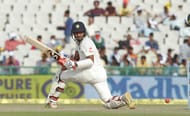
Cheteshwar Pujara was once India’s rock in the top order. He batted for days on end, scored big centuries and made significant partnerships. But once India went overseas, all that dropped. He began to get starts but soon got out. He failed to cover the stumps with the back leg, which often led to him being dismissed bowled. He tried to commit on to the front-foot, but that affected him adversely. One thing led to another, and he was dropped. Then, he was recalled for the Sri Lanka series where he made a century.
Now back home, he showed why he was still a capable batsman. In the first Test, he made scores of 31 and 77, both times forming useful partnerships with Murali Vijay to take India to a decent score. His batting was not the most aesthetic, but it was very effective. He hit a six off Imran Tahir in the second innings, which was his fourth six in four years of Test cricket. Pujara batted with gritted teeth on a pitch that had a mind of its own, and came out on top.
Once again, in the vicious Nagpur pitch, he pulled his weight to ensure that India did not collapse like usual. Keeping in mind the fragile lower-middle order, Pujara played the waiting game, giving the batsmen some time to catch his breath, and tiring out the bowlers at the same time. He made 21 and 31 in the series – not match-changing scores, but extremely important in the context of the match, for it ensured that India kept batting on a pitch that would only deteriorate as the day went on.
Pujara’s old weakness came back to haunt him in the final Test, as he was bowled in both innings. He kept missing straighter deliveries while playing for the turn, and it is a glitch he has to address. He made 202 runs in 6 innings, the fourth highest in the series.
#4 Virat Kohli (c)
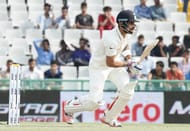
Virat Kohli had led a comeback win in Sri Lanka a month ago, and much was spoken about his captaincy. He understood the small nuances, made good bowling changes, and even employed a leg-slip which often worked. While he was not as unpredictable as his predecessor MS Dhoni, he was still a canny skipper. Once again, his tactics worked as India beat South Africa 3-0 in the Test series. While Kohli did not play a major part with the bat in the first three Tests, he made up for it with his excellent captaincy throughout the series.
He started the first Test with a patient 29 in the second innings. The message was clear – keep batting and wear the pitch down. The Indian batsmen all took their time in the middle, and by the time South Africa came out to bat, the pitch resembled a minefield. The pitch in Nagpur was similar to Mohali, so the message was the same. Kohli led by example, batting for more than an hour and scoring 22. The amount of runs did not matter, all that mattered was staying in the middle.
The plan worked again and South Africa was bundled out for 79. Kohli did not enforce the follow-on, since he knew the pitch would wear down even more. The Indian batsmen decided to play a little more straight-forwardly, and were asked to score runs. As it turned out, 8 out of the 11 Indian batsmen had a strike-rate of 50+. South Africa were set a target of 310, and they lost by 124 runs.
In the fourth Test, Kohli the batsman made his grand entrance. On an excellent pitch, he made 44 off 62 balls with seven boundaries. His cover drives were as sweet as ever, and he gave Rahane company as the latter notched his century. Kohli understood that the track had something for the pacers as he turned towards the unlikely duo of Ishant and Yadav. Both bowlers picked up crucial wickets and helped dismantle South Africa.
In the second innings, Kohli crafted an exquisite 88 off 165 balls, batting with patience to ensure that India set an unassailable target. He only fell to a ball that didn’t bounce as much, becoming another victim of the pitch.
When India bowled, he brought in Umesh Yadav to clean up the tail, which he duly delivered with a spell of 6-6-0-3. India lifted the series 3-0, and Kohli roared in delight, for this would be the first of many.
#5 AB de Villiers
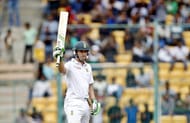
Once again, the superman from South Africa was at his best in the Test series, but he could only watch as India steamrollered them on the way to take the series. After three centuries in the ODIs, De Villiers was ready to enter the Test arena and likewise show off his range of shots. But the turning tracks on offer meant that he had to curb his style and play proper Test match cricket.
De Villiers was the major thorn in India’s side throughout the series as he played good knocks in almost every match. In the first, he made a gritty 63 as wickets fell around him. As the rest of the South Africans fell in single digit scores, he played like magic on a crumbling pitch. But he was floored by a beauty by Amit Mishra. In the second innings, he started to play a couple of shots, before he was undone by a slider.
The second Test was AB’s 100th, and he was well on his way to make a century. But even as he tried his best, he had to accelerate as South Africa were 6 down, and perished on 85 while trying to score quick runs. The third Test was a rare double failure for him as he could only make 0 and 9. It was the worst for South Africa, who folded for just 79 runs.
The fourth Test was De Villiers at his best, as he made an attacking 42 in the first innings. Then in the second innings, he showed the hidden dimension to his batting as he blocked everything that India threw at him. He made 43 off 297 deliveries, batting for almost 6 hour straight. He broke the record for the most number of deliveries faced for a sub-50 score and it was the third time in his career that he faced more than 200 balls for less than 50 runs.
But it still was not enough as South Africa lost their way in the final session. De Villiers might have ended up on the losing side, but he won a lot of fans with his batting approach.
#6 Ajinkya Rahane
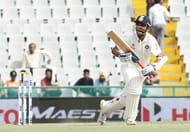
Rahane showed that one match could turn a player’s fortunes around as he smacked twin centuries in the fourth Test at Delhi. Rahane had only made 39 runs in 4 innings before the Delhi Test, and he needed to get a good score fast. He hadn’t scored a single century at home yet, and it was time to rewrite the record. Batting with captain Virat Kohli, Rahane made the most of an even pitch which was suitable to play his shots.
Rahane played a measured innings, putting away only the bad balls but taking singles and doubles off the good ones. He didn’t block too many, as he played his natural game and kept rotating the strike. He hit 11 fours and an incredible 4 sixes in his innings of 127 which ensured India got the first –and last - 300+ total of the series. In the second innings as well, Rahane was up to the task.
Coming in at a tricky 57-4, he steadied the ship once again with Kohli as the pair put on the first hundred run partnership of the series. The put together 154 runs at 3 runs per over, which was enough to force an early declaration. Once Kohli was dismissed, Rahane still continued to play his shots and reached his century in quick time, with which the declaration was complete. In the process, Rahane became the fifth Indian batsman to score twin centuries in a match after Gavaskar, Hazare, Dravid and Kohli.
Rahane also topped the list of highest number of catches, with 10 in the series. After India rotated many players in the slip regions with little success, it is heartening to see a good slip fielder like Rahane who rarely drops catches. Indian fans will hope that along with Rahane’s batting, his slip-catching also improves which would be important as India looks to achieve even more greatness.
#7 Wriddhiman Saha (wk)
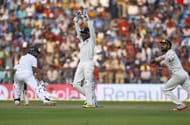
Wriddhiman Saha was the natural choice as the successor of MS Dhoni, and he certainly had huge boots to fill. But he had impressed with some good knocks in the domestic series, as well as a couple of fifties in the Test arena as well. Known as a fighter, Saha played well throughout the series, batting with the tail at times and looking to increase the score. He also kept very well on two of the most difficult tracks you can ever see, as he backed up behind the stumps with apparent ease.
Saha did not have the best start to the tournament, getting out for a duck in the first innings at Mohali. But in the second, he came in to bat when India had lost quick wickets and needed a good partnership. As wickets crumbled around him, Saha was calm. Knowing that India needed runs, he dispatched loose balls for boundaries, and was crucial in ensuring that the lead went past the 200-run mark.
He was at his best in the dustbowl at Nagpur, where again, he came in to bat with India at a precarious position. With India at 125-6, he produced one of the grittiest knocks of the series to score 32 off 106 balls. On a vicious pitch where batsmen like Amla, Kohli and De Villiers had failed to stay in the crease, Saha had faced and beaten down more than a hundred deliveries. India’s score inched over 200 once again, and they were safe. South Africa were all out for 185, and Saha had made a huge difference.
In the second innings at Delhi, Saha gave Rahane good company, scoring an unbeaten 23 off 51 balls. He understood that the run-rate needed to be increased while Rahane was searching for a century, and scored three boundaries in the process.
He also had an excellent time with gloves, keeping wickets to balls that turned square and kept low. He pulled off a spectacular catch late on the final session of the last day in Delhi, which only topped off the good series he had. His splendid performance with the gloves earned him special mention from several former cricketers, and Saha will hope to stay on as India’s wicketkeeper for a long time.
#8 Ravindra Jadeja
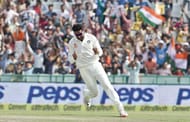
As Indian fans would say after the South Africa series – if Ashwin doesn’t get you, Jadeja will. Jadeja filled the void of the second spinner after four consecutive five-wicket hauls in the Ranji trophy. Jadeja, who was India’s best bowler two years ago, was dropped due to lack of form. But he justified his selection into the team by picking up a slew of wickets in the series.
He started by castling Faf Du Plessis and Hashim Amla in the first Test when both batsmen failed to offer a shot. His unnerving accuracy and negligible change in action sowed a lot of doubts in the minds of the batsmen as they were unsure of whether to play forward or back. This uncertainty gave Jadeja a truckload of wickets. He picked up a 5-fer in the second innings of the first Test, and that along with his 46 runs in the match earned him the Man of the match award.
He then picked up 4-50 in the washed out match at Bangalore and later took 4-33 in Nagpur. He was virtually unplayable on the spitting tracks at Nagpur where a variation of spinners, sliders and arm-balls took South Africa apart. The coup de grace came in the final Test, where his 5-30 ended South Africa’s innings at 121 runs. Though he only picked up 2 wickets in the second innings, both were partnership-breaking wickets, that of Amla and Du Plessis.
With his superb performance throughout the series, Jadeja will undoubtedly look to cement his place in the ODI series as well. He will wait and see if this is enough to earn him a recall to the shorter format of the game, and the odds look to be in his favour.
#9 Ravichandran Ashwin
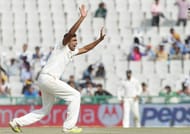
Ravichandran Ashwin has been India’s best bowler over the past year, and he showed again why he was so dangerous in home conditions. He began the slide for South Africa in the very first Test when Stiaan Van Zyl left a straighter one to be adjudged LBW. Ashwin proceeded to systematically clean out South Africa’s middle order as they all fell to the lanky offie’s variations. Ashwin finished with 5-51, celebrating his return to India. He took 3 more wickets in the second innings, but narrowly missed out on the man of the match award.
Ashwin continued on his merry way, picking up 4-70 in Bangalore, once again picking up Van Zyl, and later newcomer JP Duminy. He picked up 5-32 at Nagpur on a pitch that turned square as South Africa were bamboozled by his turn and bounce. He picked up Dean Elgar twice in the match as well as Amla and De Villiers as he ended up 12 in the match overall, picking up a well-deserved Man of the match award.
Ashwin could only pick up 2 wickets in the first innings of the fourth Test, but made up for it by scoring a timely 56. He roared back in the second innings, bowling on a dead pitch and picking up 5-61 against a South African team who had decided to block everything thrown at them. Ashwin’s 7 in the match as well his 56 runs earned him another Man of the Match award – his fifth overall, which made him the joint-highest recipient of Man of the match awards for India in Test cricket.
Ashwin also became the top ranked all-rounder in test cricket after his splendid performance, and will aim to reach the top of the bowling charts as well.
#10 Morne Morkel

The only fast bowler in the XI, it must be said that Morne Morkel truly bowled his heart out. Playing after both Steyn and Philander were out injured, Morkel ran in hard and hit the pitch harder. He was nearly unplayable with the old ball as he began to reverse it into the batsman’s stumps. Morkel was the destroyer in chief in the third Test, as he picked up 3-35 and started India’s slide. He picked up 3 crucial wickets – Vijay, Kohli and Rahane, which ensured that India did not make a big score.
He then took 3-19 in the second innings – Vijay for the second time, Rohit and then Ashwin to wrap up the Indian innings. The bounce he generated off the cracks of the pitch was too much for the Indians to handle as they wove in and out of his deliveries. He bowled nagging lines and moved the ball away from the batsmen as they simply found him too hot to handle. His six wickets in the match could have turned the game for South Africa, but their low score in the first innings meant that they would go on to lose the match.
Morkel was again at his best, taking 3-58 in the fourth Test, as his awkward bounce troubled the batsmen to no end. He picked up the wickets of Dhawan and Rohit off consecutive balls, first with a yorker and the second with a peach of a delivery that hit the seam and straightened. His heroics were not enough to give South Africa a win, but it will be heartening for them to see the big man bowl so well. In a series that was defined by spin, it was Morne Morkel’s pace which also stood out.
#11 Imran Tahir
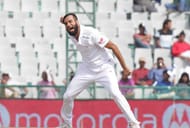
The only South African spinner who could make some sort of headway in this series was Imran Tahir. As a leg-spinner, he was something of a rarity in the cricketing world. He was facing one of the best spin-playing nations in the world, and he had to put in his best. Playing Test cricket after a gap, Tahir needed to be at his best to dismantle India at home. But despite his best efforts, India still ended up on the winning sides.
With India serving up spinning tracks, Tahir was hyped to make a good impression in the Tests. But it was Dean Elgar who stole the show at Mohali, picking up 4 wickets. Tahir picked up 6 wickets in the match, including a timely 4-48 in the second innings, but once again, South Africa ended up on the losing side. He picked up a 5-fer in the 3rd Test, with figures of 5-38, as he helped India slip from 102-2 to 128-7. But it was all for naught again as the South African batsmen failed to step up their game.
Asked to bowl on a dead pitch in Delhi did not help Tahir’s cause, as he could only pick up 2-140 in the game, ending the series on a low. He ended up as South Africa’s highest wicket taker with 14 wickets in the series, but his feat was lost in India’s series win. Tahir continues to be the dark horse of the South African bowling line-up, but he will hope that his time to shine will come soon.
Follow IPL Auction 2025 Live Updates, News & Biddings at Sportskeeda. Get the fastest updates on Mega-Auction and cricket news
